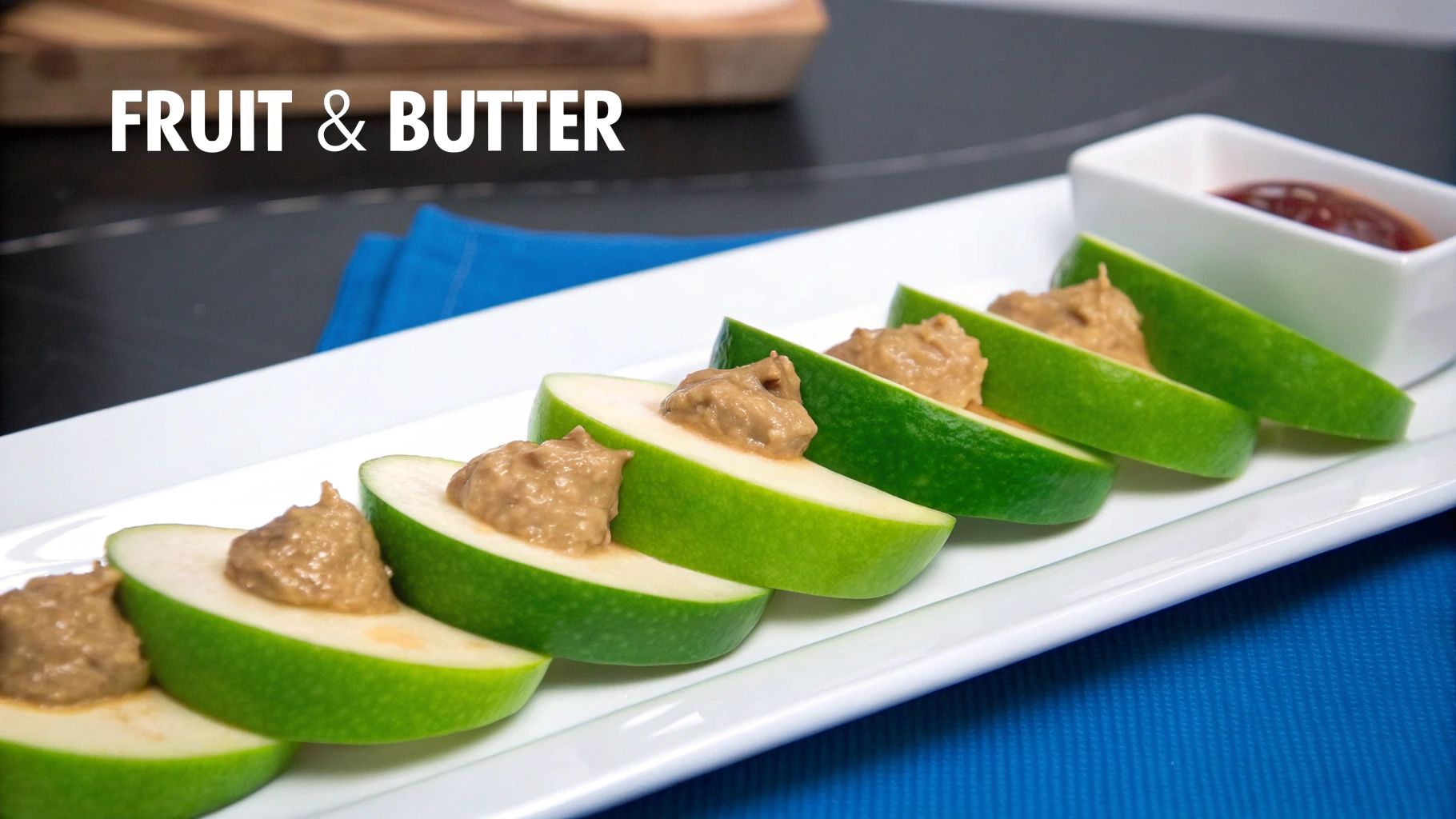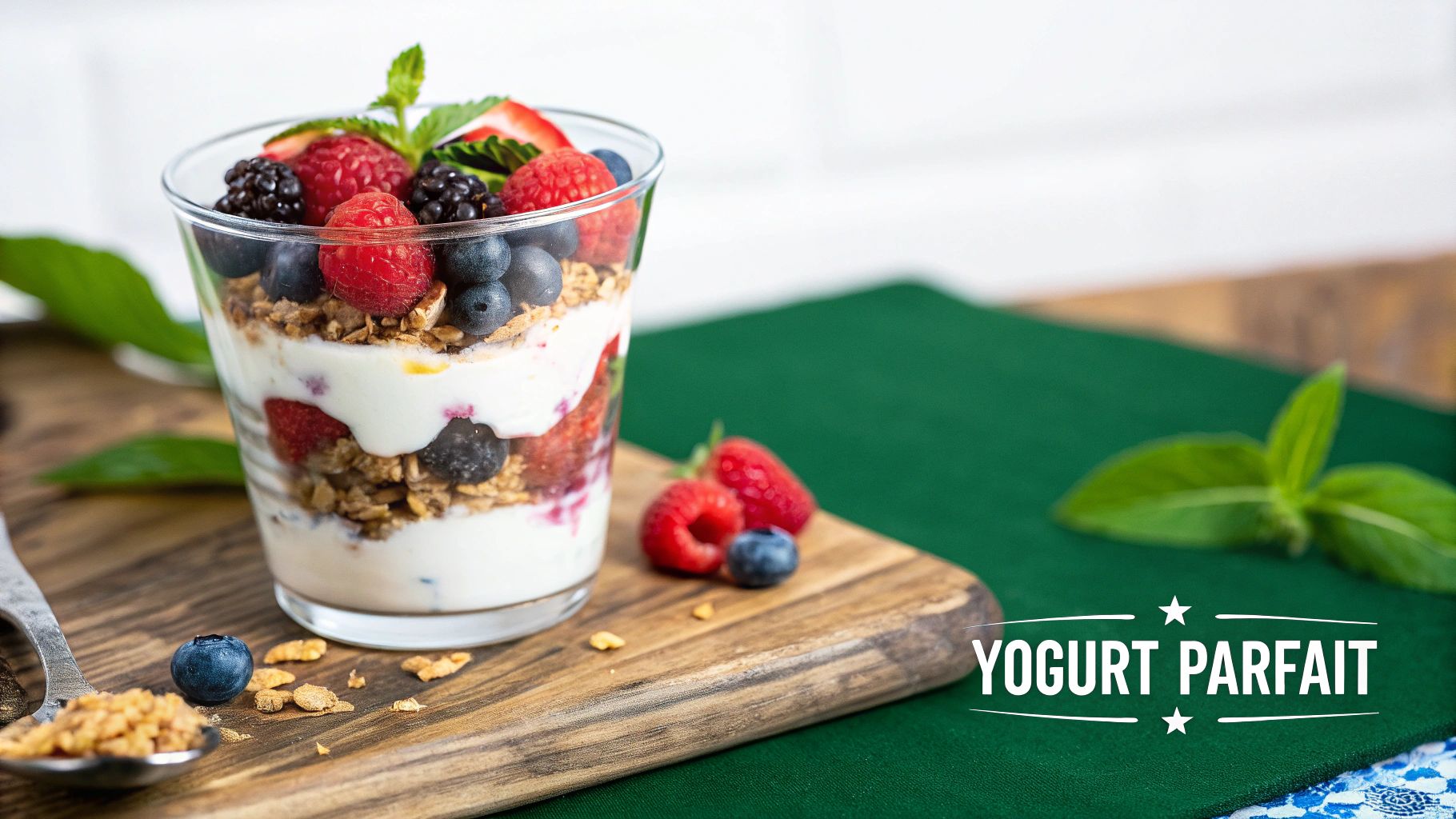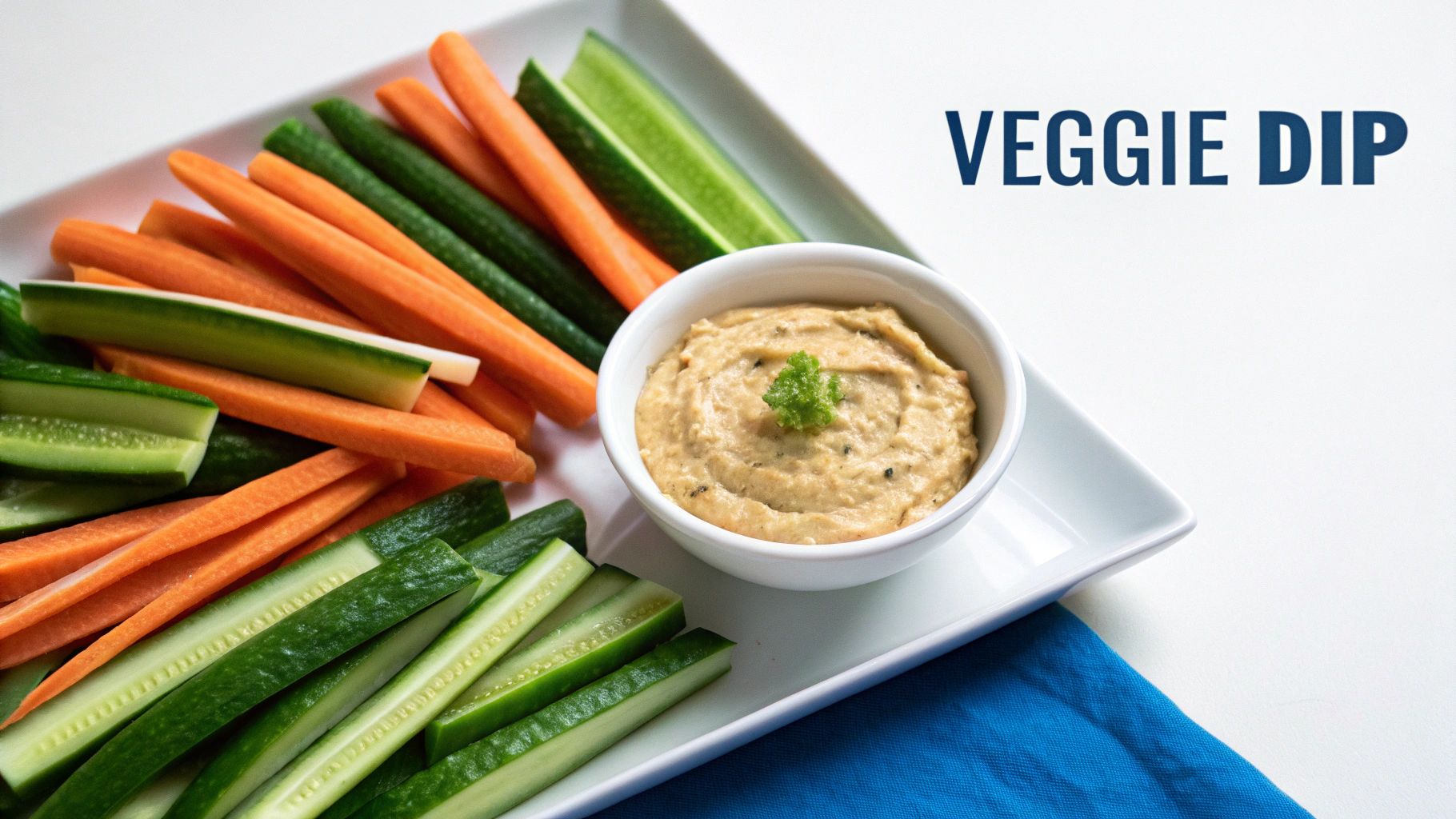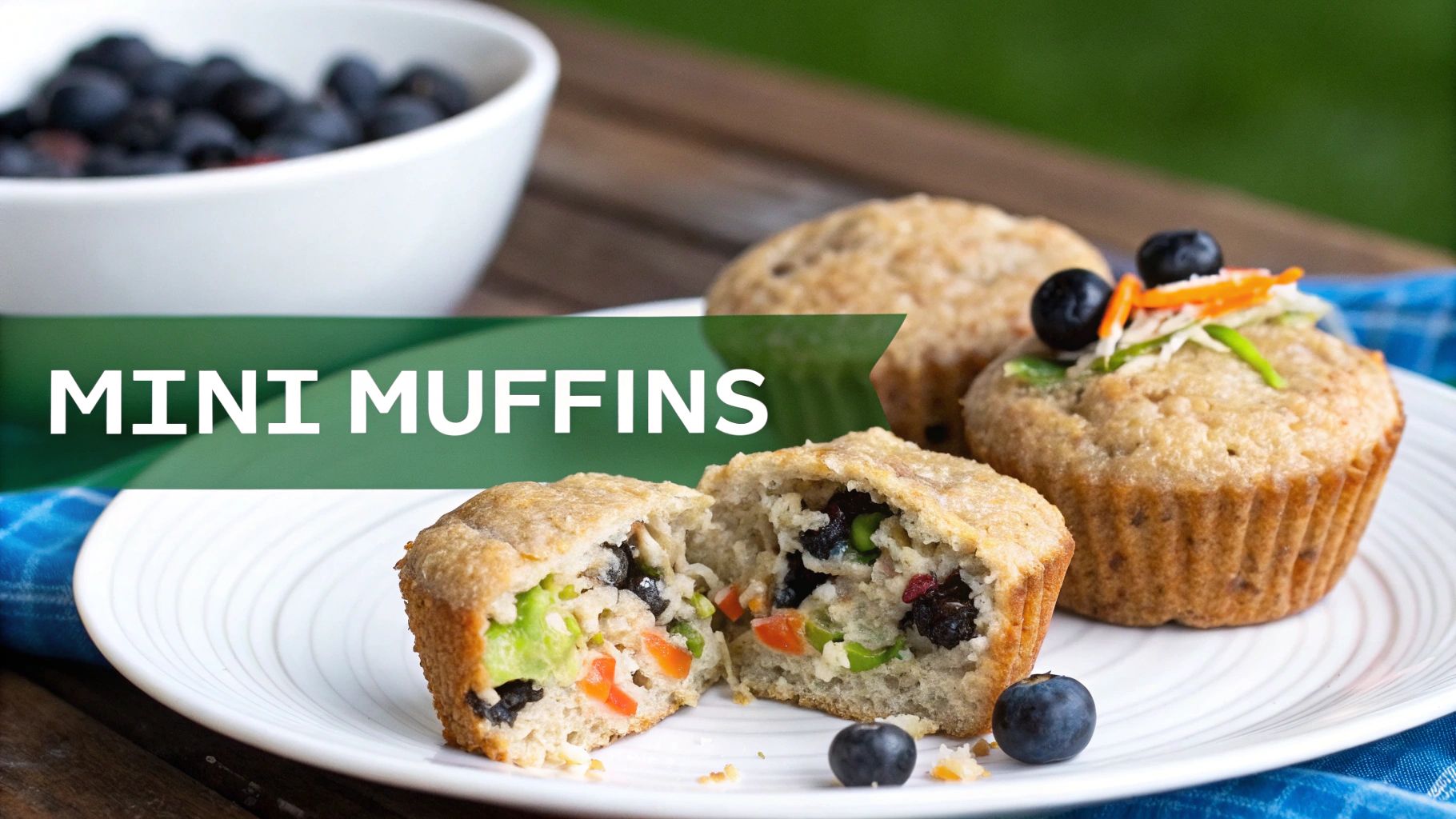7 Fresh Healthy Snack Ideas for Toddlers in 2025
Tired of the same old snacks? Discover 7 fresh, easy, and healthy snack ideas for toddlers that are both nutritious and delicious for your little ones.
Ready to Simplify Your Meal Planning?
Get personalized meal plans and grocery lists automatically matched to your macro targets.

7 Fresh Healthy Snack Ideas for Toddlers in 2025
Welcome to the wild, wonderful world of toddler snacking! It's a land of surprising preferences, sudden hunger strikes, and the eternal parental quest: finding something healthy that they will actually eat. If you feel like you're stuck in a Goldfish cracker and applesauce pouch rut, you're not alone. The constant demand for 'nacks!' can drain even the most creative parent's energy, turning a simple part of the day into a full-blown negotiation.
But what if snack time could be less of a struggle and more of a fun, nutritious adventure? What if you had a go-to list of options that were both parent-approved and toddler-adored? That's exactly what you've found. We've curated a collection of genuinely fresh and practical healthy snack ideas for toddlers that go beyond the obvious. These aren't just snacks to fill a tummy; they are powerful mini-meals packed with brain-boosting fats, muscle-building proteins, and smile-inducing flavors. From Fruit and Nut Butter combos to Mini Muffin masterpieces, each idea is simple, actionable, and designed for real life. Get ready to transform your snack game from chaos to calm, delicious confidence.
1. Fruit and Nut Butter Combinations
Welcome to the snack-time hall of fame! Fruit and nut butter is the toddler equivalent of a classic power couple, like peanut butter and jelly but with a nutritional glow-up. This dynamic duo pairs the natural sweetness and fiber of fresh fruit with the satisfying protein and healthy fats of nut or seed butter, creating a balanced snack that provides lasting energy, not a sugar crash.
This isn’t just about slapping some peanut butter on an apple. It’s a genius method for introducing textures, developing fine motor skills (hello, pincer grasp!), and building a foundation for healthy eating habits that will hopefully last longer than their obsession with that one specific blue crayon.

Why It's a Toddler-Taming Triumph
The beauty of this snack lies in its simplicity and nutritional punch. The protein and fat from the nut butter slow down the absorption of sugar from the fruit, which means your toddler gets sustained energy for epic living room obstacle courses instead of a brief, wild burst followed by a meltdown. It's one of the most effective and healthy snack ideas for toddlers because it checks all the boxes: tasty, nutritious, and easy.
This concept is so trusted that it's a staple in many professional settings. Daycare centers often serve apple slices with sunflower seed butter as a clever, allergy-friendly option, while Montessori schools use it as a self-serve station to foster independence. Even pediatric nutritionists, like Maryann Jacobsen, champion this combination for its balanced macronutrients.
How to Serve It Safely and Smartly
Prepping this snack is a breeze, but a few safety tips are key to keeping it fun and choke-free.
- Spread it Thin: A thick glob of nut butter is a major choking hazard. Always spread a very thin layer onto fruit slices. You can even warm the butter slightly to make it more liquid and easier to spread.
- Cut for Your Kid: Slice fruit into age-appropriate shapes. Think thin, matchstick-style apple slices or half-moon banana cuts for younger toddlers.
- Go Au Naturel: Choose natural nut or seed butters with minimal ingredients, ideally just nuts and maybe a pinch of salt. Avoid brands with added sugars, hydrogenated oils, or other unnecessary additives.
- Allergen Awareness: If you're introducing a new nut, do it at home and watch for any reactions. For nut-free environments like schools or playgroups, sunflower seed or pumpkin seed butters are fantastic alternatives.
2. Greek Yogurt Parfaits
Move over, sugary pudding cups. The Greek yogurt parfait is here to claim the throne as the creamiest, dreamiest, and most nutritionally stacked snack in the toddler kingdom. This isn't just a bowl of yogurt; it's a customizable, layered creation that combines protein-packed Greek yogurt with the vibrant sweetness of fresh fruit and the satisfying crunch of whole grains. It’s a sensory experience that’s as fun to make as it is to eat.
This snack is a parent's secret weapon for delivering probiotics for gut health, calcium for strong bones, and a serious dose of protein for muscle development and sustained energy. It’s the perfect canvas for introducing new fruits and textures, turning snack time into a colorful, interactive activity instead of a nutritional negotiation.

Why It's a Toddler-Taming Triumph
The genius of the Greek yogurt parfait lies in its impressive protein content. Greek yogurt typically has double the protein of its regular counterpart, which is crucial for a toddler's rapid growth. This high-protein base means your little one stays full and satisfied longer, preventing the dreaded pre-dinner "hanger" that can derail an entire evening. It’s one of the most versatile and healthy snack ideas for toddlers because it can be adapted for breakfast, a midday snack, or even a healthy dessert.
This concept is so effective that it's a go-to in professional childcare and pediatric settings. Hospital pediatric departments often recommend yogurt parfaits to parents of picky eaters as a gentle way to introduce new foods. Feeding experts like the team at Feeding Littles praise it for its balanced macronutrients, while brands like Chobani and Stonyfield Organic have made it a household staple, proving its widespread appeal and nutritional credibility.
How to Serve It Safely and Smartly
Building a perfect parfait is simple, but a few key considerations ensure it’s both safe and nutritious for your toddler.
- Go Plain to Gain: Start with plain, whole-milk Greek yogurt. Flavored yogurts are often loaded with added sugars. You can control the sweetness by adding fresh fruit or a tiny drizzle of maple syrup (only for toddlers over 12 months).
- Fruit First: Stick to soft, easy-to-chew fruits like mashed berries, diced mango, or ripe peaches. Cut everything into small, manageable pieces to minimize choking risks.
- Crunch with Caution: If adding granola or cereal, choose low-sugar options and only offer it to older toddlers who have mastered chewing. For younger tots, finely crushed whole-grain cereal can provide texture without the hazard.
- Get Them Involved: Let your toddler help! Scooping yogurt and dropping berries into a clear cup is a fantastic way to build their independence and get them excited to eat what they’ve made.
3. Vegetable Sticks with Hummus
Get ready to turn "eww, veggies" into "more, please!" with the ultimate crunchy-creamy combo: vegetable sticks and hummus. This isn't just a snack; it's a sensory experience and a sneaky-smart way to pack nutrients into your toddler’s day. It pairs the crisp, hydrating crunch of fresh veggies with the savory, satisfying creaminess of hummus, creating one of the most interactive and healthy snack ideas for toddlers.
This classic pairing is a genius move for teaching toddlers that vegetables are friends, not food to be flung across the room. It empowers them to dip, scoop, and crunch on their own terms, transforming snack time from a battle of wills into a fun, hands-on activity. It’s a win for their taste buds and a major victory for their developing motor skills.

Why It's a Toddler-Taming Triumph
The magic here is in the dip. Hummus, made from chickpeas, provides a fantastic source of plant-based protein and fiber, which helps keep tiny tummies full and energy levels stable. This combination is a nutritional powerhouse, offering vitamins, fiber, and protein all in one delicious package, which helps avoid the dreaded pre-dinner hanger.
This isn't just a home-kitchen hack. Pediatric occupational therapists often use veggie dipping as a playful therapy tool to improve fine motor skills and sensory processing. Feeding experts like Ellyn Satter praise this kind of interactive eating for fostering a positive relationship with food, while platforms like Kids Eat in Color consistently showcase it as a top-tier way to introduce and normalize vegetables. Even popular brands like Sabra and Hope Foods are staples in daycare centers for this very reason.
How to Serve It Safely and Smartly
Making this snack toddler-friendly is simple, but a few key preparations can ensure it's both safe and appealing.
- Soften the Crunch: For younger toddlers, lightly steam hard vegetables like carrots or broccoli florets until they are tender-crisp. This significantly reduces choking risk while keeping them firm enough for dipping.
- Cut for Control: Slice vegetables into thick sticks or "fries" that are easy for little hands to grasp. Cucumbers, bell peppers, and zucchini are great raw options.
- Start Sweet: Introduce naturally sweeter veggies first, like red or yellow bell pepper strips and sugar snap peas, to entice picky palates.
- DIY Dip: Making hummus at home is incredibly easy and allows you to control the sodium and tahini (a potential allergen) content. Plus, you can sneak in other veggies like roasted sweet potato or beets for extra nutrients and fun colors.
- Shape it Up: Use small cookie cutters to create fun shapes from cucumber slices or bell peppers. A star-shaped veggie is infinitely more exciting than a boring old stick
4. Whole Grain Mini Muffins
Get ready to master the art of the stealthy-healthy snack. Whole grain mini muffins are the Trojan horse of toddler nutrition, a delicious and familiar treat that secretly smuggles in fruits, vegetables, and fiber. Perfectly sized for tiny hands, these muffins offer the comfort of a baked good while delivering complex carbohydrates for long-lasting playground fuel.
This isn’t just about baking; it's a meal-prep superpower. A single batch can solve your snack-time dilemmas for a week, providing a convenient, grab-and-go option that’s leaps and bounds better than most pre-packaged snacks. They are a fantastic way to introduce new flavors and textures in a non-intimidating, cake-like form.

Why It's a Toddler-Taming Triumph
The genius of the mini muffin is its versatility and nutritional density. Unlike sugary, refined-flour bakery muffins, these whole grain versions provide sustained energy from complex carbs, preventing the dreaded sugar-induced chaos. They are one of the most brilliant healthy snack ideas for toddlers because they can be customized to suit picky eaters while packing in essential nutrients.
This concept is widely embraced by parents and professionals alike. Mom bloggers like Catherine McCord of Weelicious have built entire platforms on the idea of "hidden veggie" recipes, with muffins being a star player. Brands like Kodiak Cakes and Simple Mills offer popular, protein-packed mixes, while children's nutrition experts like Annabel Karmel consistently feature muffin recipes as a foundational toddler snack.
How to Serve It Safely and Smartly
Baking these little bites is simple, and with a few smart tweaks, you can maximize their health benefits and convenience.
- Boost the Fiber: Swap half the all-purpose flour in any recipe with whole wheat flour. For an extra boost, add a tablespoon of ground flaxseed or chia seeds for healthy omega-3 fats.
- Cut the Sugar: Reduce the sugar called for in a recipe by half, or replace it entirely with natural sweeteners like mashed banana or unsweetened applesauce. This also adds moisture, reducing the need for oil.
- Sneak in Veggies: Finely shredded zucchini or carrot disappears into the batter, adding vitamins and moisture. You can’t taste them, but your toddler gets the benefits.
- Prep for Success: Use silicone mini muffin pans for easy, non-stick removal. Once cooled, freeze the muffins on a baking sheet before transferring them to a freezer bag. This way, you can grab one at a time for a quick-thawing snack.
5. Cheese Cubes and Whole Grain Crackers
Step aside, fancy snacks. Sometimes, the most legendary toddler-pleasers are the ones that have been fueling playground adventures for generations. Cheese and crackers are the tried-and-true power couple of the snacking world, offering a perfect harmony of savory crunch and creamy satisfaction that few toddlers can resist. This duo delivers protein and calcium from the cheese alongside sustained energy from whole-grain carbohydrates.
More than just a quick bite, this combination is a fantastic tool for encouraging independent eating. The small pieces are perfect for little hands to practice their pincer grasp, transforming snack time into a low-key developmental win. It's a simple, no-cook solution for busy parents looking for healthy snack ideas for toddlers that don't require a culinary degree to prepare.
Why It's a Toddler-Taming Triumph
The genius of this snack is its nutritional synergy. The protein in the cheese helps to stabilize blood sugar levels, preventing the energy spikes and subsequent crashes that can lead to meltdowns. It provides lasting fuel for everything from block-building marathons to serious story-time sessions, making it one of the most reliable healthy snack ideas for toddlers.
This classic pairing is so effective that it’s endorsed across various child-focused institutions. Many preschools serve cheddar cubes and whole wheat crackers as a go-to snack, and brands like Sargento have built entire product lines like Balanced Breaks around this concept. The American Academy of Pediatrics also includes it in its nutrition guidelines as a balanced choice for growing kids, cementing its status as a trusted staple.
How to Serve It Safely and Smartly
While this snack is incredibly simple, a few guidelines will ensure it’s both safe and nutritious for your little one.
- Cut Cheese Correctly: To minimize choking risks, cut cheese into small, manageable pieces. Think thin slices or tiny cubes no larger than half an inch.
- Choose Whole Grains: Opt for crackers made from 100% whole grains to maximize fiber content. Look for brands with at least 2 grams of fiber per serving and a short ingredient list.
- Go for Real Cheese: Steer clear of processed cheese products, which can be high in sodium and additives. Stick to natural cheeses like mild cheddar, mozzarella, or Swiss.
- Make it Fun: Arrange the crackers and cheese in a fun shape, like a smiley face or a caterpillar, to entice picky eaters and add a touch of playfulness to snack time.
6. Smoothie Bowls or Pouches
Step right up and witness the magic of liquified nutrition! Smoothie bowls and pouches are the ultimate secret weapon for parents. They’re a delicious Trojan horse, smuggling in a payload of fruits, veggies, and healthy fats under the guise of a sweet, slurpy treat. This is your chance to blend that dreaded spinach or kale into a purple concoction they’ll actually ask for.
More than just a drink, smoothies are a versatile solution for picky eaters and busy schedules. They pack a nutritional punch that can support your toddler's boundless energy, whether served in a bowl for a sit-down sensory experience or in a pouch for those inevitable on-the-go moments.
Why It's a Toddler-Taming Triumph
The genius of smoothies lies in their blendability. You can combine multiple food groups into one easy-to-consume format, making it one of the most efficient healthy snack ideas for toddlers. A single serving can deliver vitamins from fruit, fiber from vegetables, protein from yogurt, and healthy fats from avocado or seed butter, promoting satiety and stable blood sugar.
This isn't just a home-kitchen hack. Brands like Once Upon a Farm have built entire businesses on cold-pressed smoothie pouches for kids. Many preschools famously serve "green monster" smoothies to get kids excited about vegetables, and Jennifer Anderson of Kids Eat in Color often showcases them as a low-pressure way to introduce new foods. It’s a trusted strategy for delivering dense nutrition in a format toddlers love.
How to Serve It Safely and Smartly
Crafting the perfect smoothie is an art, but these tips ensure it's both nutritious and safe for your little one.
- Balance the Blend: Aim for a 2:1 ratio of fruit to vegetables to maintain a kid-friendly sweetness. Mild greens like spinach are a great starting point, as their flavor is easily masked by berries.
- Boost the Good Stuff: Add a scoop of Greek yogurt for protein, a spoonful of chia seeds for fiber, or a slice of avocado for creamy, healthy fats. This turns a simple fruit drink into a well-rounded mini-meal.
- Pouch or Bowl?: For on-the-go ease, reusable pouches are eco-friendly and cost-effective. At home, serve it in a bowl with toppings like hemp hearts or crushed O-shaped cereal to encourage chewing and slow down consumption.
- Freeze for Future Fun: Freeze leftover smoothie mix in ice cube trays for quick, portioned snacks later. You can also freeze overripe bananas to use as a creamy, naturally sweet base for future blends.
7. Hard-Boiled Eggs
Meet the humble, oval-shaped superstar of the snack world. The hard-boiled egg is nature's perfect single-serving power pack, delivering a satisfying dose of protein and healthy fats in a convenient, portable package. It’s an old-school classic that has earned its permanent spot in the toddler-snacking hall of fame for a reason.
This isn't just a quick breakfast food; it's a tool for fostering independence and nourishing a growing brain. Offering a hard-boiled egg is a simple yet brilliant way to provide complete nutrition, support brain development, and keep your little one full and focused until the next meal.
Why It's a Toddler-Taming Triumph
The brilliance of the hard-boiled egg lies in its dense nutritional profile. Each egg contains all nine essential amino acids, making it a complete protein source. It’s also rich in choline and healthy fats, which are crucial for brain development. This makes it one of the best healthy snack ideas for toddlers, providing lasting energy without a sugar spike.
This concept is widely endorsed by professionals. Montessori schools famously use egg peeling as a practical life activity to build fine motor skills. Pediatric nutritionists and baby-led weaning resources like Solid Starts often recommend eggs as a fantastic first finger food. Even high-quality brands like Vital Farms have popularized the egg as a go-to, nutrient-rich option for families.
How to Serve It Safely and Smartly
Prepping eggs is simple, but a few serving tricks will make them a safe and exciting snack for your toddler.
- Cut for Your Kid: A whole egg can be a choking hazard for young toddlers. Slice it into quarters lengthwise or chop it into small, manageable pieces. For older toddlers with more chewing experience, halves work well.
- Cool It Down: After cooking, immediately plunge eggs into an ice bath. This stops the cooking process and makes them significantly easier to peel, saving you from a frustrating battle with tiny shell fragments.
- Boost the Flavor: While delicious on their own, you can boost the appeal by mashing the egg with a bit of Greek yogurt and a sprinkle of dill to create a quick, healthy egg salad.
- Batch and Store: Boil a half-dozen eggs at the start of the week for grab-and-go snacks. You can store unpeeled eggs in the fridge for up to a week. Peeled eggs should be stored in a container of cold water and eaten within a couple of days.
Healthy Snack Ideas: 7-Item Comparison Guide
| Snack Item | Implementation Complexity 🔄 | Resource Requirements ⚡ | Expected Outcomes 📊 | Ideal Use Cases 💡 | Key Advantages ⭐ |
| Fruit and Nut Butter Combinations | Low (simple slicing/spreading) | Minimal (fresh fruit, nut butter) | Balanced nutrition with protein, fats, and natural sugars | Quick snack, allergy-adaptable, on-the-go snacks | Nutritious, customizable, sustained energy |
| Greek Yogurt Parfaits | Moderate (layering ingredients) | Requires refrigeration, yogurt, fruits | High protein and calcium, supports gut health | Morning snack, picky eaters, make-ahead option | Protein-rich, probiotic benefits, versatile |
| Vegetable Sticks with Hummus | Moderate-high (cutting, steaming) | Vegetables, hummus dip | Introduces vegetables, vitamins, fiber, protein | Encouraging vegetable intake, fine motor skill development | Nutrient diverse, sensory development, engaging |
| Whole Grain Mini Muffins | High (baking, preparation time) | Ingredients for baking, oven | Provides complex carbs, hidden veggies/fruits | Meal prep, batch cooking, finger food | Customizable, portable, nutrient-dense |
| Cheese Cubes and Whole Grain Crackers | Low (simple assembling) | Cheese, whole grain crackers | Balanced protein, fat, carbs for bone, brain development | Convenient snack, self-feeding practice | Quick, balanced nutrition, appeals to toddlers |
| Smoothie Bowls or Pouches | Moderate (blending, prep) | Blender, fruits, veggies, dairy or alternatives | Nutrient-dense, multiple food groups, customizable | On-the-go nutrition, disguised veggies | Highly customizable, nutrient-packed, hydrating |
| Hard-Boiled Eggs | Moderate (cooking, peeling) | Eggs, cooker or pot | Complete protein, brain development nutrients | Batch cooking, portable protein snack | Economical, nutrient complete, supports cognition |
Making Snack Time Your Superpower
And there you have it, a veritable arsenal of healthy snack ideas for toddlers designed to conquer the dreaded "I'm hungry" wail. From the simple delight of fruit sticks dipped in nut butter to the satisfying crunch of whole grain crackers with cheese, you're now equipped with a diverse lineup that goes far beyond the usual suspects. This isn't just a list of recipes; it's a blueprint for transforming snack time from a daily challenge into a joyful, nutrient-packed adventure.
The real magic happens when you start thinking of these ideas not as individual snacks, but as building blocks. Remember, variety is your secret weapon against the picky eating monster. A toddler who sees, smells, and tastes a wide array of foods is more likely to become an adventurous eater for life.
The True Takeaway: It's All About the Toolkit
The most important lesson isn't about memorizing how to make the perfect mini muffin or the creamiest hummus. Instead, it’s about building a flexible “snack toolkit” that works for your family.
- Prep for Success: Dedicate an hour on Sunday to wash and chop veggies, hard-boil a few eggs, or bake a batch of muffins. This small investment of time pays huge dividends during a chaotic week. Your future self will thank you when you can grab a ready-to-go, healthy option in seconds.
- Involve Your Co-Chef: Toddlers are infinitely more likely to eat something they helped create. Let them mash the avocado, stir the yogurt, or sprinkle toppings on a smoothie bowl. It empowers them, teaches them valuable skills, and makes them part of the process.
- Patience is a Virtue (and a Strategy): Don't be discouraged if a new snack is met with a suspicious glare. It can take 10, 15, or even 20 exposures for a child to accept a new food. Offer it without pressure, eat it yourself with enthusiasm, and try again another day.
Mastering this approach means more than just a well-fed toddler. It means less stress for you, fewer mealtime battles, and the profound satisfaction of knowing you’re building a foundation of healthy habits that can last a lifetime. You're not just filling a tummy; you're shaping a palate and nurturing a positive relationship with food. That's a true parenting superpower. By embracing these healthy snack ideas for toddlers, you reclaim your time and energy, turning a daily chore into a moment of connection.
---
Ready to put your meal and snack planning on autopilot? Meal Flow AI can generate a full week of toddler-friendly recipes, complete with a grocery list you can send directly to Instacart. Stop decision fatigue and start enjoying more moments with your little one by visiting Meal Flow AI to see how it works